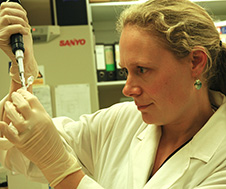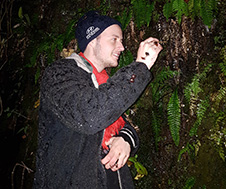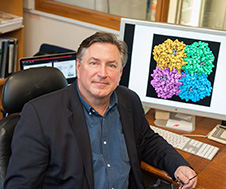 Tuesday 20 February 2018 9:09am
Tuesday 20 February 2018 9:09am

Dr Miriam Sharpe, Department of Biochemistry.
University of Otago researchers have helped uncover how New Zealand glowworms produce their glow. A multi-year study of the bioluminescence produced by the glowworms has been published today in the highly respected online science journal, Scientific Reports.
The study titled "New Zealand glowworm bioluminescence is produced by a firefly-like luciferase but an entirely new luciferin," was a collaborative effort between Otago's Chemistry and Biochemistry departments.
Lead authors Doctors Oliver Watkins and Miriam Sharpe, working with Professors Nigel Perry (Chemistry) and Kurt Krause (Biochemistry), have discovered that the New Zealand glowworms produce their light using a chemical reaction that is different to all other glowing creatures like fireflies.
All light made by living creatures comes from chemical reactions that take place in enzymes called luciferases.

Dr Oliver Watkins, Department of Biochemistry.
“What we have discovered is that the chemical, called a luciferin, which makes light in New Zealand glowworms is unique, not used by any other glowing organism. However, the glow-worm luciferase enzyme is related to enzymes already found in other bioluminescent organisms like fireflies,” says Dr Sharpe.
“No-one expected that this type of luciferase could make light with more than one kind of luciferin chemical.”
Professor Krause says these findings are an important addition to our knowledge of glow-worms and notes that, the chemical that creates their glow could have important uses in the medical biotechnology sector.

Professor Kurt Krause, Department of Biochemistry.
“For instance, the light-generation taking place in the glowworm's 'taillight' could potentially be used in the laboratory to monitor cancer cells or to help identify infectious diseases. The chemistry behind some bioluminescent species, such as fireflies, is already used in scientific experiments world-wide. We believe the novel chemistry of the glowworms means their light could be used in similar kinds of experiments,” says Dr Krause.
Professor Perry says for the full potential of glowworm's new chemistry to be exploited the next step is to synthesize the chemical compound that makes the light, i.e. the luciferin, in the laboratory. This is a key step to enable utilization of the glowworm chemistry in any laboratory application.
The research team are now hoping to secure the funding needed to begin this synthesis and to continue their work.
 Professor Nigel Perry, Department of Chemistry.
Professor Nigel Perry, Department of Chemistry.
Dr Sharpe's work has been supported by the former Foundation for Research Science and Innovation (now the New Zealand Ministry for Business, Innovation and Employment), and the Marsden Fund of New Zealand, and Dr Watkins' research was supported by a PhD Scholarship from the University of Otago.
For further comment please contact:
Dr Miriam Sharpe
Department of Biochemistry
University of Otago
+64 3 479 7704
Email: miriam.sharpe@otago.ac.nz
Professor Kurt Krause
Department of Biochemistry
University of Otago
+64 3 479 7864
Email: kurt.krause@otago.ac.nz
Professor Nigel Perry
Department of Chemistry
University of Otago
+64 3 479 8354
Email: nigel.perry@otago.ac.nz
Mark Hathaway
Senior Communications Adviser
University of Otago
+64 21 279 5016
Email: mark.hathaway@otago.ac.nz
A list of Otago experts available for media comment is available elsewhere on this website.
Electronic addresses (including email accounts, instant messaging services, or telephone accounts) published on this page are for the sole purpose of contact with the individuals concerned, in their capacity as officers, employees or students of the University of Otago, or their respective organisation. Publication of any such electronic address is not to be taken as consent to receive unsolicited commercial electronic messages by the address holder.
